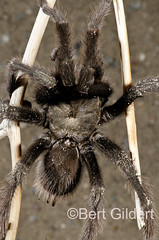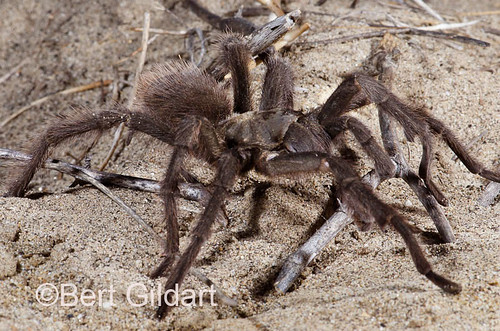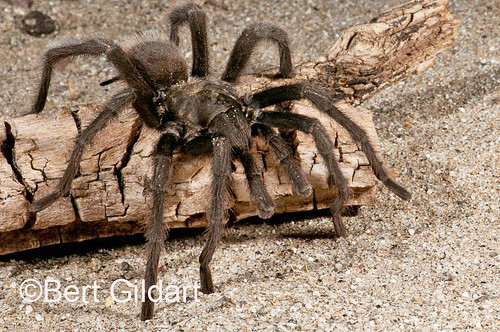Big Beaut Of a Tarantula
 ©Bert Gildart: For almost two weeks now, Janie and I have been hoping nightly to find one of the migrating tarantulas, which folks here say they see with much regularity during the month of October. However, up until two nights ago we hadn’t seen a one, but then suddenly we saw three. (But we saw several in the Grand Canyon.)
©Bert Gildart: For almost two weeks now, Janie and I have been hoping nightly to find one of the migrating tarantulas, which folks here say they see with much regularity during the month of October. However, up until two nights ago we hadn’t seen a one, but then suddenly we saw three. (But we saw several in the Grand Canyon.)
Two, however, had been injured on the road, but last night, Charlie Colladay, an Airstream owner, Disney Studio artist, and fanatic and very impressive bike rider — and I were peddling when suddenly, Charlie pointed, and said, “There’s one. It’s huge and it sure is a beaut.”
Charlie agreed to stand watch while I quickly biked back to our camp, got Janie, loaded my camera in the truck, and then quickly returned to see what had happened during the 15 minutes I’d been gone.
BIG BEAUT
Charlie was there, and so was the tarantula, restrained in a big hole, almost a pit. And, yes, it was big. Charlie who once owned a tarantula as a pet said that locally, tarantulas usually measure about 2-4 inches, but a hurried tape placement showed this beaut to be unusually big, for its body measured slightly more than the four-inch max.
Making it appear even larger were its eight legs which projected out from the body, and each of them were matted with dark hairs. On top of its head were eight tiny eyes looking like little more than spots of desert sand. But these tiny spots work to locate prey and they do so in a most interesting fashion. A pair of main eyes peers forward while the other three serve to locate prey peripherally. In other words, they have their world pretty well covered.
NOTE: Click any of these photos for a much enlarged view.
Though tarantulas have a reputation for being docile they will bite if angered. What’s more they can eject the tiny hairs from both their back legs and from their stomachs — all of which can create immense itching. To avoid problems I coaxed my monster on a long stick which had been lying nearby. I then moved it to what Charlie thought was an appropriate setting.
PHOTO DETAILS
At this point, photography became a three-way effort. Charlie and Janie each held a strobe activated by the well thought out Nikon wireless speedlight system. The challenge was to render the creature in focus from front leg to back leg, something strobes facilitate because they are so powerful. As a result you can use such a narrow aperture, in this case, f-22 or even an f-32. Settings were made on both my D-7000 and on my 105mm Nikon Macro lens.
Tarantulas are truly an amazing spider, and are placed in the Class Arachnida. Typically, you’ll find them in grasslands, chaparrals, canyons or in desert areas. October – and now I guess – November, too, is the time of year, males (about 6-7 years old) strike out across the desert, looking for females, warm and comfy in their webbed burrows.
When males find one of these love nests, mating occurs, despite the fact males are sometimes injured in the process. Occasionally a female may even devour its injured mate.
HAVE A GOOD LIFE
Janie, Charlie and I worked with our tarantula (we assume it was a wandering male) for about an hour, gently moving it from one location to another. Elevating it, we also photographed our Arachnid’s underneath, which shows those tiny abdominal hairs that can cause such itching. We all agreed our tarantula was a “good tarantula,” and that as a group they are a fascinating animal, one which should be appreciated for all of its adaptations.
Because we found our tarantula on the road, we eventually released it to a spot well away from traffic, hoping that in this way it would have a long and productive life.
———————————————————————————————-
AIRSTREAM TRAVELS SIX YEARS AGO:
ADS FROM AMAZON AND GOOGLE AUGMENT OUR TRAVELS:
(You can order our new books (shown below ) from Amazon — or you can order them directly from the Gildarts. Bert will knock a dollar off the list price of $16.95, but he must add the cost of book-rate mailing and the mailer, which are $2.25. The grand total then is $18.20. Please send checks to Bert Gildart at 1676 Riverside Road, Bigfork, MT 59911.)




November 11th, 2012 at 11:31 am
Oh Bert, you are sooooo lucky. You have a WHOOPER of a Tarantula to play with!
It reminds me of a scorpion you once knew.
November 13th, 2012 at 8:24 am
And I still recall how you risked life and limb holding that strobe just inches from the stinger of our visitor. It was a bark scorpion, the most painful of them all. Didn’t think that was too much to ask.
November 13th, 2012 at 5:02 pm
Yes, but you didn’t tell me it was the most painful of all the scorpions. I guess it helped that it was so small I could hardly see it!
November 14th, 2012 at 3:39 pm
How is it that every time you find a potentially painful creature you manage to have innocent bystanders to hold props or flashes inches away? Kind of like Marlin Perkins narrating the old Mutual of Omaha Wild Kingdom show: “We’ll wait here while Jim wrestles with the alligator. You know, one bite from that creature could crush his spine …”
November 18th, 2012 at 11:59 am
[...] at The Springs at Borrego and joined us for lunch and a day of celebrating Thanksgiving, life, tarantulas, Montana Icons (Bert’s latest book), the 2012 presidential election, and our [...]